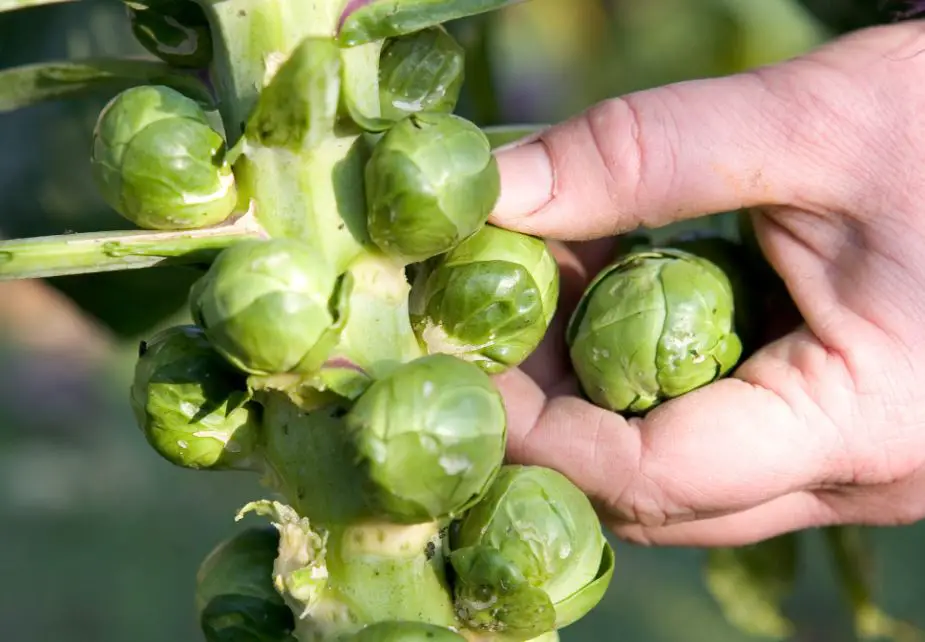A home gardener may grow brussels sprouts, one of the healthiest superfoods. The cabbage family includes Brussels sprouts, which are quite simple to grow. Nevertheless, growers sometimes discover that their Brussels sprouts are not growing those little heads that resemble cabbage.

No Brussels Sprouts on my Plants
Sometimes it is preferable to begin solving a gardening issue by evaluating the health of the plants. The same problems that affect other cabbage family members also affect Brussels sprouts. The following are the most prevalent pests and illnesses that might harm your plants’ health and productivity:
- Fusarium wilt: The lower leaves will begin to yellow or turn brown as the first symptom of this fungus illness. The plants will wilt, as the name implies, and their growth will be impeded.
- Black leg: Plants with black legs may become stunted or turn yellow and die. Black cankers can identify them on the stem.
- Black rot: The traditional signs of black rot are black veins and brownish, v-shaped regions beginning at the margin of leaves.
- Cabbage worms: Some Brussels sprouts’ crowns have tunnels made by cabbage worms, which eat holes in the leaves. The fact that these worms mix in with the foliage makes them tough to notice, in addition to the fact that they are incredibly damaging.
When plants are healthy, have plenty of leaves, and are free of pests, it is time to discover why your Brussels sprouts did not grow heads.
Brussels Sprouts Growing Requirements
Improper growth conditions are among the most frequent causes of Brussels sprouts’ lack of head development. Take into account the following conditions for healthy Brussels sprout growth:
- Long growing season: For Brussels sprouts to reach their golf-ball-sized heads, they need a minimum of 80 to 100 days of growth, depending on the variety. Choose a variety that will grow well throughout your growing season.
- Incorrect growth season: A cool-season crop that can withstand below-freezing temperatures, Brussels sprouts. Although northern farmers will discover that this crop performs best with an autumn harvest date, southern gardeners may grow Brussels sprouts as a winter crop.
- Bolting: Despite the frost resistance of this crop, planting Brussels sprouts in cooler locations in the early spring may not provide the plants enough time to grow before summer. Plant Brussels sprouts as soon as there is a risk of frost to avoid bolting.
- Sprouts that are loose and fluffy: When Brussels sprouts grow at temperatures over 70 degrees Fahrenheit (21 degrees Celsius), the heads often lack the proper taste and firmness. Use the days to maturity information on the seed packaging to calculate the ideal planting dates required to ensure cool-weather bud growth to get around this issue.
- Insufficient water: Brussels sprouts can grow in dry soil, but a consistent water level in the soil helps the sprouts grow.
- Nutrient deficiency: Brussels sprouts, like other cabbage family members, are hefty eaters. Place this crop on soil rich in compost, and fertilize it occasionally during the growing season. Get your soil tested to see whether the nitrogen levels are sufficient.
- Competition: Brussels sprouts plants should be spaced 2 to 3 feet (.6 to.9 m) apart to prevent competition for nutrients. Grow Brussels sprouts apart from other plants that need intensive feedings, such as broccoli, cauliflower, or tomatoes.
Brussels sprouts: Should I Remove the Leaves?
Maybe you have seen plants with their bottom leaves removed, and you are curious how this kind of pruning influences the growth of Brussels sprouts. Let us first consider how Brussels sprouts grow to respond to this.
Tiny little heads that resemble cabbage grow in the space between the main stem and the leaves. Sprout development starts at the base of the plant and works its way up. Naturally, a greater harvest will be produced by plants with more leaves.
Premature leaf removal from Brussels sprout plants will impair their capacity to create energy via photosynthesis and may impact bud development. However, lower leaves should not be removed until they start to turn yellow. It will increase air flow, giving sprouts more area to develop and minimizing the risk of the plant bowing as it fills up with sprouts.
Around three weeks before harvest, some gardeners remove 2 to 3 inches (5-7.6 cm) of the plant’s top. This technique redirects energy toward sprout growth while simultaneously encouraging stem bud maturation.


